Go-lab project
Introduction
Go-lab is an online platform for science teaching. It allows teachers to create structured inquiry learning scenarios.
According to de Jong et al. (2014), “The Go-Lab federation of online labs opens up virtual laboratories (simulation), remote laboratories (real equipment accessible at distance) and data sets from physical laboratory experiments (together called “online labs”) for large-scale use in education. In this way, Go-Lab enables inquiry-based learning that promotes acquisition of deep conceptual domain knowledge and inquiry skills, with the further intent of interesting students in careers in science. For students, Go-Lab offers the opportunity to perform scientific experiments with online labs in pedagogically structured learning spaces. Go-Lab’s inquiry learning spaces (ILSs) structure the students’ inquiry process through an inquiry cycle and provide students with guidance in which dedicated (and connected) scaffolds for inquiry processes play a pivotal role. Teachers can create and adapt inquiry learning phases and the associated guidance in an ILS through a simple wiki-like interface and can add scaffolds and tools to an ILS using a straightforward drag and drop feature.”
See also:
The go-lab ecosystem
According to the about page (May 13, 2019), “The Go-Lab Ecosystem (or the Go-Lab Sharing and Authoring Platform) targets science teachers from primary and secondary schools and aims to help them enrich their teaching practices with innovative teaching approaches and supportive technical tools. The Go-Lab Ecosystem consists of the two main components: The Go-Lab Sharing Platform provides a large collection of quality-proven remote and virtual laboratories (“Labs”), shared by renowned research institutions and technology providers from all over the world. [..] Furthermore, multiple web-applications (“Apps”) are offered, supporting students in their inquiry learning activities and teachers in the preparation, implementation, and monitoring of these activities. Finally, teachers have a possibility to share Inquiry Learning Spaces (“Spaces”) they create for their students with other teachers [..]. The Go-Lab Authoring Platform enables teachers to easily create Inquiry Learning Spaces, which are virtual spaces, structured according to the phases of the inquiry learning process and containing online labs, inquiry learning apps, and any other multimedia learning materials selected by the teacher”
Below are the main entry points together with quotations from the respective web pages (retrieved May 13 2019)
- Online Labs “provide your students with the possibility to conduct scientific experiments in an online environment. Remotely-operated labs (remote labs) offer an opportunity to experiment with real equipment from remote locations. Virtual labs simulate the scientific equipment. Data sets present data from already performed lab experiments.”
- Inquiry learning apps “are dedicated software tools that help students in their inquiry learning tasks and help students to create hypotheses, design experiments, make predictions, formulate interpretations of the data, etc. Other learning apps present students, for example, with a quiz or allow students to view online teacher feedback.”
- Inquiry Learning Spaces “are personalized learning resources for students, including a lab, apps, and any other type of multimedia material. ILSs follow an inquiry cycle”
- Graasp is the authoring environments for creating Inquiry Learning Spaces.
Examples
Images below were copied from De Jong, Sotiriou, & Gillet (2014) [1], an article available under a Creative Commons Attribution License By 4.0 license.
Go-lab includes a number of simulation environments, also called "virtual labs". These are similar to the ones can be found in other environments, e.g. PhET interactive simulations.
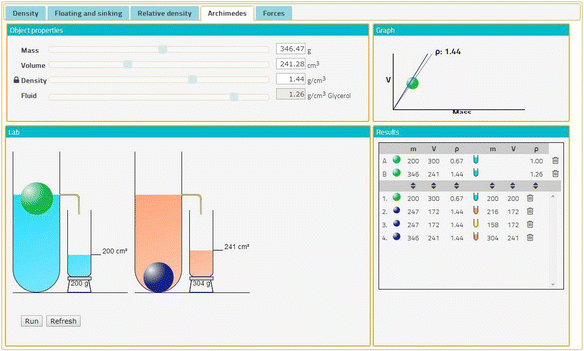
The following picture shows lab equipment that can be remotely controlled and shows the set up for a chemistry experiment on production of methyl orange. [2]
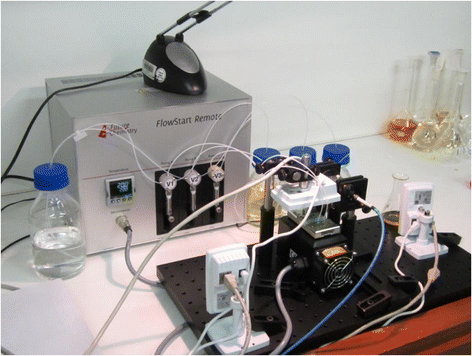
Some apps are more complex environments. E.g. in the electrical circuit lab, learners “create their own electrical circuits and do measurements on it. In the circuits the students can use resistors, light bulbs, switches, capacitors and coils. The circuits can be powered by a AC/DC power supply or batteries. There is an ammeter, voltmeter, wattmeter and an ohmmeter.” (retrieved May 13 2019).
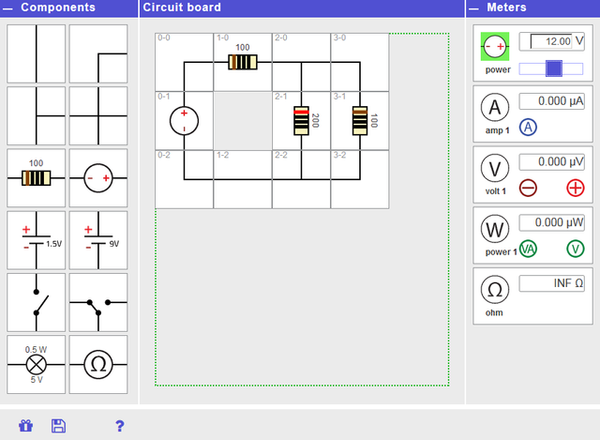
A circuit can be built by dragging around the components. Some squares, e.g. the resistors can be editing by double clicking-
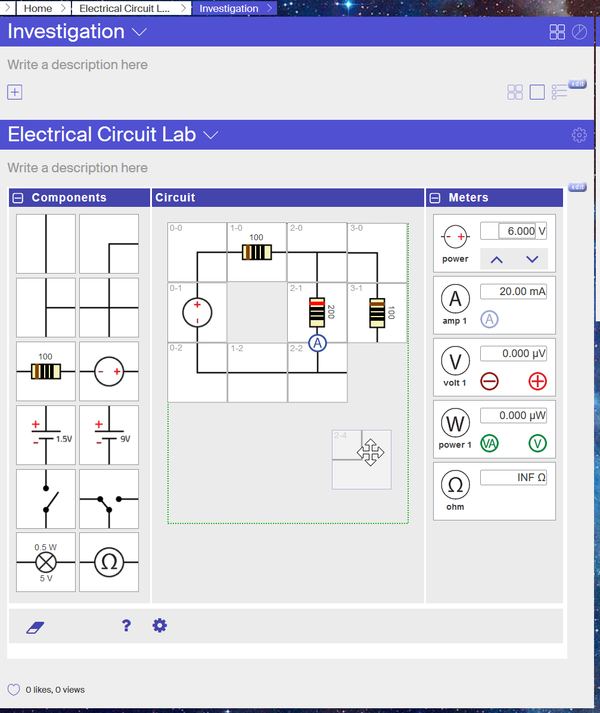
The next image shows Hypothesis scratchpad, a conceptual tool that is available to configure Inquiry-based learning scenarios. It allows students to compose hypotheses by dragging and combining predefined terms or by using self-defined terms or sentences and is based on prior work by van Joolingen and de Jong (1991). [3]
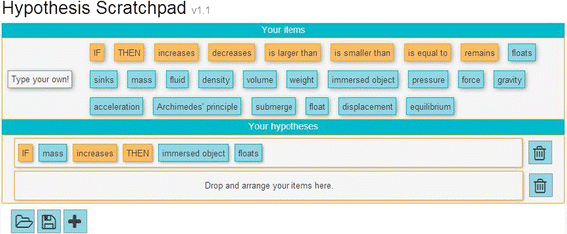
The following picture shows an initial version of the Inquiry Learning Space (ILS). Learners and teachers can cycle through TABS on top that include the different phases.
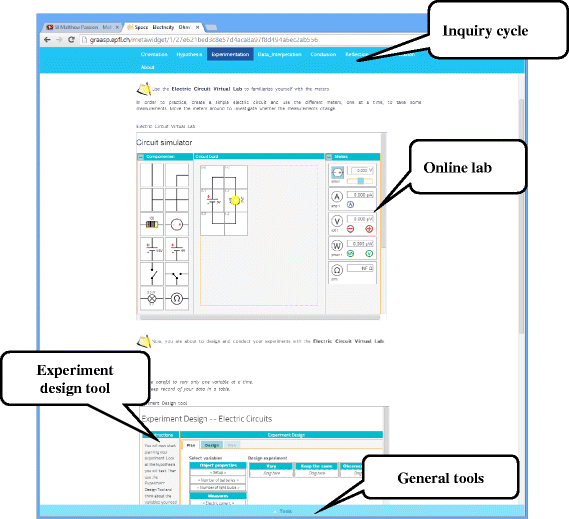
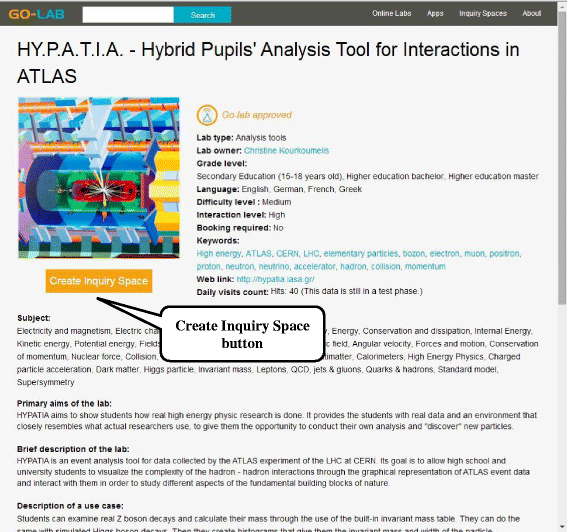
Bibliography
De Jong, T. (2016). Instruction based on computer simulations and virtual labs. In: R.E. Mayer & P.A. Alexander (Eds.), Handbook of research on learning and instruction (Volume II), p. 1123-1167. Publication Publisher: Routledge Press.
De Jong, T.; Sotiriou, S.; Gillet, D.:Innovations in STEM education: The Go-Lab federation of online labs.Smart Learning Environments, 1, 3,2014 https://link.springer.com/article/10.1186/s40561-014-0003-6
Dikke, D.; Tsourlidaki, E.; Zervas, P.; Cao, Y.; Faltin, N.; Sotiriou, S.; Sampson, D.:GOLABZ: Towards a federation of online labs for inquiry-based science education at school.In: Proceedings of the 6th International Conference on Education and New Learning Technologies (EDULEARN2014, Barcelona, Spain). IATED Publications,2014
Dikke, D., & Faltin, N. (2015, July). Go-Lab MOOC–An online course for teacher professional development in the field of Inquiry-Based Science Education. In 7th International Conference on Education and New Learning Technologies. https://telearn.archives-ouvertes.fr/hal-01206503/document
Hovardas, T., Pedaste, M., Zacharia, Z., & de Jong, T. (2018). Model-Based Inquiry in Computer-Supported Learning Environments: The Case of Go-Lab. Cyber-Physical Laboratories in Engineering and Science Education, 241-268. https://link.springer.com/chapter/10.1007%2F978-3-319-76935-6_10
References
- ↑ De Jong, T.; Sotiriou, S.; Gillet, D.:Innovations in STEM education: The Go-Lab federation of online labs.Smart Learning Environments, 1, 3,2014 https://link.springer.com/article/10.1186/s40561-014-0003-6
- ↑ van Rens L, van Dijk H, Mulder J, Nieuwland P: Using a web application to conduct and investigate syntheses of methyl orange remotely. J. Chem. Educ. 2013, 90: 574–577. doi:10.1021/ed300719q doi:10.1021/ed300719q 10.1021/ed300719q
- ↑ van Joolingen WR, de Jong T: Supporting hypothesis generation by learners exploring an interactive computer simulation. Instr. Sci. 1991, 20: 389–404. doi:10.1007/BF00116355 doi:10.1007/BF00116355 10.1007/BF00116355